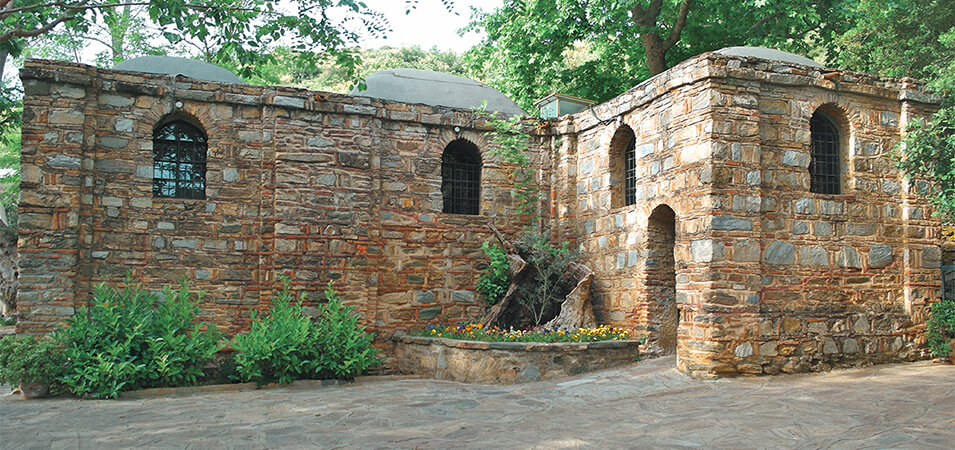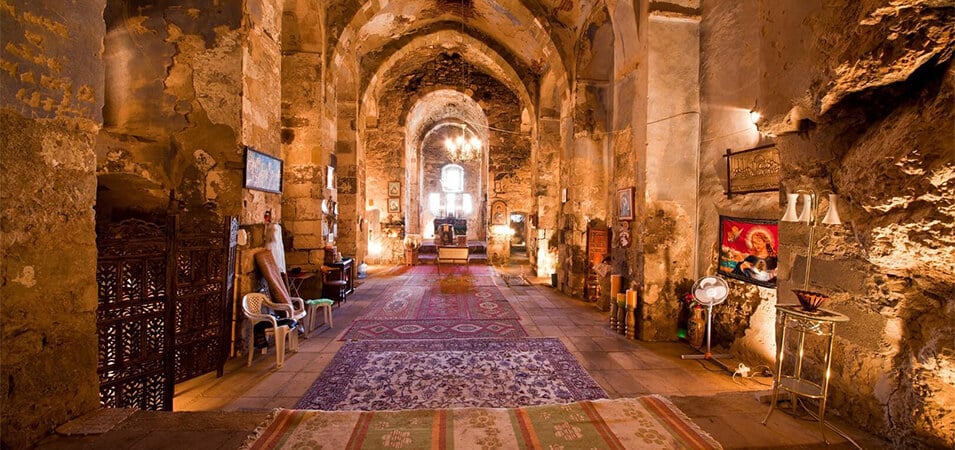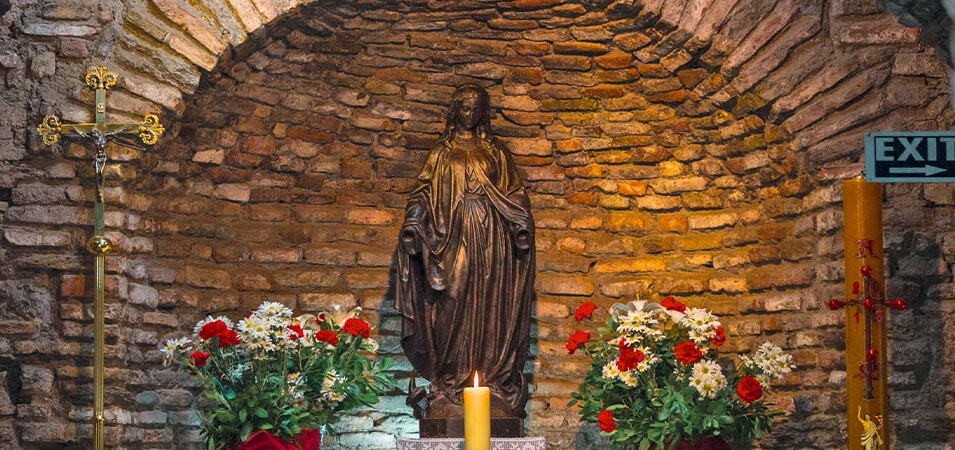Many people in Turkey hold the House of the Virgin Mary in high regard and consider it a sacred site. It is thought that the Virgin Mary, the mother of Jesus Christ, died in this tiny house on Mount Koressos, near the old city of Ephesus.
The Christian story says that after Jesus was crucified, the apostle John took Mary to Ephesus, where she lived out her last years alone. People believe that Mary went to heaven from this spot, giving it much spiritual meaning for Christians worldwide.
The House of the Virgin Mary, also called Meryemana in Turkish, is where many travelers and tourists go to pay their thanks and find peace. The simple stone building, which has been rebuilt over time, keeps the spirit of Mary’s presence and makes followers feel that it is accurate.
People from all over the world come to the House of the Virgin Mary in Turkey to feel the spiritual energy that flows through this holy place, which is a sign of the long-lasting faith and love that Mary inspired.
Don’t Miss checking out our Turkey Tour Packages.
Historical Background of the House of Virgin Mary

The History of the House of Mary
The House of the Virgin Mary in Turkey has a long history that includes links to the Bible. Even though the house is not mentioned directly in the Bible, it is essential because of old stories and practices passed down through the years.
Biblical Connections
- Residence in Ephesus: Christian belief says that after Jesus Christ was crucified, the apostle John took Mary, Jesus’ mother, to Ephesus, an important city in Asia Minor. People think that Jesus gave John the job of taking care of Mary.
- Mary’s Last House: The House of the Virgin Mary is Mary’s last home in Ephesus. People think she lived there until she died and went to heaven.
Traditions and Legends
- The Apostle John’s Role: Tradition says that the apostle John built a small house for Mary on Mount Koressos, near Ephesus. Because John was close to Mary and lived in Ephesus, the house has come to be associated with her.
- The Discovery of the House: Anne Catherine Emmerich, a German saint and dreamer who lived in the early 1800s, is said to have found the house. Emmerich saw and talked about the place in great detail, which helped researchers find its position.
- Papal Recognition: Pope Leo XIII made it a tourist site in 1896 after investigating the house to ensure it was real. Following that, various popes supported and recognized it, which increased its significance as a holy location for Christians.
- Ecumenical Pilgrimage Destination: People come from around the world to visit the House of the Virgin Mary, which has become an important worship site for Christians of different faiths. The place is interesting because it is connected to Mary, an essential Christian, and has a spiritual environment.
Architectural Features and Preservation
The architecture of the House of the Virgin Mary shows how important it is historically and religiously. Much work has been done to keep this holy spot safe for future generations.
Architectural Style and Features
- Modest Stone Structure: The House of the Virgin Mary is built modestly. The house is made of stone from the area, and the walls give off an air of modesty and simplicity. Its simple look matches the idea that Mary lived a simple life.
- Sacred Symbols: Inside the house, people can see crosses, religious paintings, statues, and other holy symbols and items related to Mary. These things add to the place’s spiritual mood and the respect people have for it.
Efforts to protect
- Building back up and fixing up: Over the years, people have worked to rebuild and fix up the House of the Virgin Mary to stay true to its history. These projects have involved careful study, historical digs, and building experience to ensure the spot is accurate.
- Conservation Measures: Measures have been implemented to keep the spot from worsening. These include keeping the building in good shape, regularly checking it, and using suitable materials to minimize damage from nature.
- Visitor Guidelines: There are rules for visitors to make sure the House of the Virgin Mary stays in good shape. These rules usually say that you can’t take pictures, can only go to certain places, and can only be a few people at once.
- Working with religious leaders: Religious leaders, historical groups, and government bodies often work together to keep the House of the Virgin Mary in good shape. These agreements ensure the place gets the care and funding it needs to be safe in the long run.

Religious Significance and Pilgrimage
Christians, especially Catholics, think of the House of the Virgin Mary as a holy place because it is connected to the life of the Virgin Mary.
Religious Significance
- The Last Place Mary Lived: Catholics believe with all their hearts that Mary spent her last years in the House of the Virgin Mary. The house is an important place in the Christian faith because it is thought to be where Mary stayed, prayed, and was taken to heaven.
- Connection to Mary’s Role: Mary is an essential part of the Catholic faith as the Mother of God. The House of the Virgin Mary shows her faithfulness, obedience, and desire to be how God’s plan for salvation was carried out. It shows Mary’s importance in Jesus’s life and the Christian faith.
Pilgrimage Tradition
- The Spiritual Path: Christians worldwide now go on pilgrimages to the House of the Virgin Mary. Pilgrims go on a spiritual trip to visit the spot because they want to connect with Mary and their faith more deeply.
- Seeking Spiritual Blessings: Pilgrims often pray, think, and do other acts of worship on the spot in hopes of receiving spiritual gifts and direction. The House of the Virgin Mary is a place where Christians can show their faith, make requests, and ask Mary to help them.
- Respect and Devotion: Pilgrimages to the House of the Virgin Mary are a way for Christians to show their respect for Mary and honor her as the mother of Jesus and an example of faith.
Importance in Christian Faith
The House of the Virgin Mary is an integral part of the Christian faith because it is a physical link between Christians and Mary. It is a physical memory of Mary’s presence and her vast effect on Jesus’ life. It emphasizes her role as an advocate and the spiritual connection between the faithful and the Mother of God.
Location and Setting of House of Virgin Mary
The House of the Virgin Mary in Turkey is in a beautiful part of the country, which adds to its appeal as a spiritual site.
Beautiful Place
The house has a beautiful setting on Mount Koressos, near the old city of Ephesus. Because of the sweeping landscape views and surrounding lush grass, it is a tranquil place to escape the busy outside world.
The natural environment
The House of the Virgin Mary is peaceful because of its natural setting. The area has rolling hills, pine woods that smell good, and a light breeze that stirs the trees. The relaxed environment encourages respect and thought, giving tourists a quiet place to think and pray.
Peaceful Ambiance
The peaceful mood of the spot makes it an excellent place to think about your spiritual life. The lack of modern buildings and the natural environment that has yet to be changed make it feel more holy and peaceful. Visitors often say that walking around the grounds and seeing the small stone building that is thought to have been the Virgin Mary’s home gives them peace and a spiritual connection.

Conclusion
The House of the Virgin Mary in Turkey is a holy place of religious, cultural, and political importance. This simple stone house is prominent in Christian tradition because it is thought to be where the Virgin Mary lived at the end of her life. It is a sign of the lasting faith and love that Mary inspired.
The historical ties of the House of the Virgin Mary, which are based on old customs and tales, give a tangible link to the life and role of Mary in the Christian faith. Its position on Mount Koressos, surrounded by beautiful scenery, gives it a peaceful and spiritual atmosphere that draws people in.
Don’t Miss checking out our Related Article :
